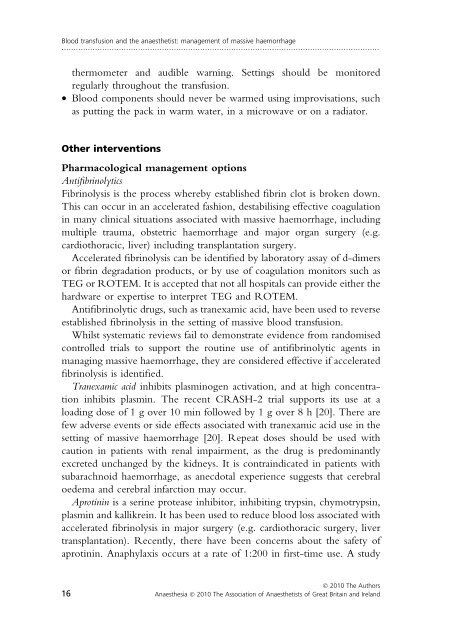Blood transfusion and the anaesthetist: management of ... - aagbi
Blood transfusion and the anaesthetist: management of ... - aagbi
Blood transfusion and the anaesthetist: management of ... - aagbi
Create successful ePaper yourself
Turn your PDF publications into a flip-book with our unique Google optimized e-Paper software.
<strong>Blood</strong> <strong>transfusion</strong> <strong>and</strong> <strong>the</strong> anaes<strong>the</strong>tist: <strong>management</strong> <strong>of</strong> massive haemorrhage<br />
.....................................................................................................................................<br />
<strong>the</strong>rmometer <strong>and</strong> audible warning. Settings should be monitored<br />
regularly throughout <strong>the</strong> <strong>transfusion</strong>.<br />
• <strong>Blood</strong> components should never be warmed using improvisations, such<br />
as putting <strong>the</strong> pack in warm water, in a microwave or on a radiator.<br />
O<strong>the</strong>r interventions<br />
Pharmacological <strong>management</strong> options<br />
Antifibrinolytics<br />
Fibrinolysis is <strong>the</strong> process whereby established fibrin clot is broken down.<br />
This can occur in an accelerated fashion, destabilising effective coagulation<br />
in many clinical situations associated with massive haemorrhage, including<br />
multiple trauma, obstetric haemorrhage <strong>and</strong> major organ surgery (e.g.<br />
cardiothoracic, liver) including transplantation surgery.<br />
Accelerated fibrinolysis can be identified by laboratory assay <strong>of</strong> d-dimers<br />
or fibrin degradation products, or by use <strong>of</strong> coagulation monitors such as<br />
TEG or ROTEM. It is accepted that not all hospitals can provide ei<strong>the</strong>r <strong>the</strong><br />
hardware or expertise to interpret TEG <strong>and</strong> ROTEM.<br />
Antifibrinolytic drugs, such as tranexamic acid, have been used to reverse<br />
established fibrinolysis in <strong>the</strong> setting <strong>of</strong> massive blood <strong>transfusion</strong>.<br />
Whilst systematic reviews fail to demonstrate evidence from r<strong>and</strong>omised<br />
controlled trials to support <strong>the</strong> routine use <strong>of</strong> antifibrinolytic agents in<br />
managing massive haemorrhage, <strong>the</strong>y are considered effective if accelerated<br />
fibrinolysis is identified.<br />
Tranexamic acid inhibits plasminogen activation, <strong>and</strong> at high concentration<br />
inhibits plasmin. The recent CRASH-2 trial supports its use at a<br />
loading dose <strong>of</strong> 1 g over 10 min followed by 1 g over 8 h [20]. There are<br />
few adverse events or side effects associated with tranexamic acid use in <strong>the</strong><br />
setting <strong>of</strong> massive haemorrhage [20]. Repeat doses should be used with<br />
caution in patients with renal impairment, as <strong>the</strong> drug is predominantly<br />
excreted unchanged by <strong>the</strong> kidneys. It is contraindicated in patients with<br />
subarachnoid haemorrhage, as anecdotal experience suggests that cerebral<br />
oedema <strong>and</strong> cerebral infarction may occur.<br />
Aprotinin is a serine protease inhibitor, inhibiting trypsin, chymotrypsin,<br />
plasmin <strong>and</strong> kallikrein. It has been used to reduce blood loss associated with<br />
accelerated fibrinolysis in major surgery (e.g. cardiothoracic surgery, liver<br />
transplantation). Recently, <strong>the</strong>re have been concerns about <strong>the</strong> safety <strong>of</strong><br />
aprotinin. Anaphylaxis occurs at a rate <strong>of</strong> 1:200 in first-time use. A study<br />
Ó 2010 The Authors<br />
16 Anaes<strong>the</strong>sia Ó 2010 The Association <strong>of</strong> Anaes<strong>the</strong>tists <strong>of</strong> Great Britain <strong>and</strong> Irel<strong>and</strong>

















